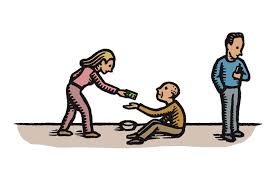EMPATHY
1/16
There's no tags or description
Looks like no tags are added yet.
Name | Mastery | Learn | Test | Matching | Spaced |
|---|
No study sessions yet.
17 Terms
Sally-Anne experiments
TOM
Where will sally look for her ball
Kids under 3 will say Sally will look in the box - dont understand they have a different perspective than Sally
Kids 4-5 start to say Sally will look in the basket (even though they saw anne move the ball, they understand Sally does not have this information)
Emotional Empathy
Objective: to understand the similarities and differences in brain activation between pain experience and pain empathy
Subjects: 16 romantic couples
Methods: female partners brain activity was assessed in an MRI when her right hand received a shock and when she saw her partners hand received shock
results: Insula is very important for pain empathy
More activity in insula increased with higher empathy
Altruism
Objective: do extreme altruists have a better ability to empathize with others in distress by more closely mapping representations of themselves and others in the brain
Subject: kidney donors and non-kidney donors
Methods:
Watched as a stranger anticipated and experienced pressure-brain stimulation to right thumbnail
Watched the stranger anticipating and experiencing pain after being told to empathize with them
Subjects themselves anticipated the pressure-pain stimulation in their right thumbnail
Measured brain activity
results: In response to anticipating of pain in themselves or observed in the stranger, altruists had more activity in the left insula
emotional empathy - psychopathy
Usually studied in relation to painful experiences
In fmri scanners, subjects were shown images of different painful or neutral situations
Imagined how painful each would be for either themselves or someone else
Men in prison asked imagine if this is happening to you and
results: Reduced emotional empathy activation is associated with increased psychopathy
When asked to imagine other perspective people with the high psychopathic traits had lower amygdala size
Psychopathy - reduced response to fearful faces
Boys with conduct problems and callous-unemotional traits were assessed while viewing a fearful face and normal face and the boys were asked to give the persons gender (not asking them about fear) and then measured if there was activation when viewing fearful faces
Decreased amygdala activation to fearful facial expressions
psychopathy - fear conditioning
People with psychopathy typically show reduced physiological response to fear conditioning
Skin conductance
Neural reactivity
Men with traits and control and were shown faces with two mustaches and two not - and conditioned the painful shock with the main with a mustache and the non mustache with no shock
Non control when they saw the mustache photo they had an increased skin conductance (shot up)
Control (psychopaths) when they saw the mustache photo they did not have an increase
hyper reactive NAcc
Hyper reactive dopamine reward system is associated with impulsivity and antisocial behavioral traits
Used fmri and pet after administering amphetamine or placebo
results: Higher amphetamine induced dopamine release in NAcc associated with psychopathic traits
what is empathy
feeling what others feel (different sympathy)
development of empathy
less than 12 months old
what is altruism
Voluntary , costly, non reciprocal behavior aimed at benefiting the well-being of another individual
Extreme altruists (heroic rescues, directed/non-directed organ or bone marrow donors, humanitarian aid workers, etc)
High Honesty-Humility – relative value of outcomes for self vs others
Low Personal Distress – tendencies to experience personal distress in an emergency
Related to well-being

what is psychopathy
Developmental disorder defined by affective deficits and antisocial behavior
Highly comorbid with substance use disorders
what are the affective deficits in factor 1 of psychopathy diagnosis
shallow emotions
lack of empathy
lack of remorse/guilt
what are the antisocial behaviors in factor 2 of psychopathy diagnosis
impulsivity
early behavioral problems
poor control of anger
pathological lying
what is the fast thalamic pathway in fear
fast, crude, immediate detection of danger and initiation of response
(thalamus-amygdala)
cat with cucumber
what is the cortical pathway in fear
slower, more precise, reassessment of danger
(visual thalamus-visual cortex-amygdala)
what brain regions are involved in fear
Amygdala sends to all of these parts of the brain
Striatum: integrated motor response; reward, goal-directed behavior
Hypothalamus: defense reactions
Hippocampal formation: context, memory
Orbitofrontal cortex: goal directed behavior
Temporal lobe: visual processing
case study of the industrial psychopath
“As things stand, we do not know the prevalence of
psychopathy among those who work on Wall Street. It may be
even higher than 10%, on the assumption that psychopathic
entrepreneurs and risk-takers tend to gravitate toward
financial watering-holes, particularly those that are
enormously lucrative and poorly regulated...